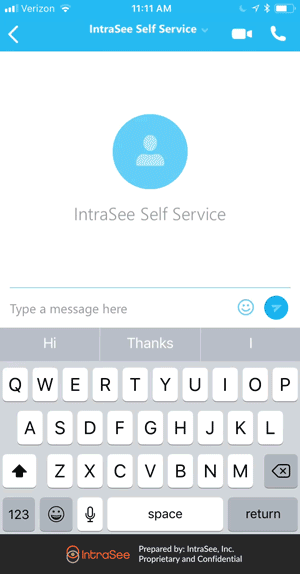Chatbots have been the talk of the town for the past year, and it’s become very apparent that their time has now come. That all said, there are already well-known horror stories of organizations that have wasted tens of millions of dollars attempting to implement AI solutions. At IntraSee we figured that now was the time to give the lowdown on where the market stands, and what we think people need to be aware of when implementing a chatbot solution in their organization. And in true IntraSee style, we’ll do this via our Q&A format.
Q: Are AI and chatbots ready for the market now, or is it all hype?
A: There’s no doubt that the hype-train is running full steam with AI right now and at some point reality will settle in. But at the same time, there are elements of AI that are ready to be used now. The trick is to know what to use and how to use it. But we at IntraSee can firmly say that chatbots are the element of AI that is now market ready (for the most part).
Yes, not all chatbots are created equal, and it’s important that each organization picks the right chatbot for the right job. There are many vendors in the marketplace and some are much better than others.
Q: I’ve heard that once you implement a chatbot solution that it takes about a year before it gets intelligent enough to add value. Is that right?
A: Well, only if you’ve not implemented it properly. One thing that has become very apparent is that all the large consulting companies see chatbots as a new revenue stream. So, their focus is on staffing as many people as possible on these kinds of projects, while also setting expectations low with their clients.
The facts are that if a Chatbot is implemented correctly you will see value from day one. If your implementation partner can’t deliver on this, then maybe you need a new implementation partner.
Q: So how long does an implementation take? I’ve heard that over a year is pretty normal, with a large team of consultants to assist.
A: If the vendor is a “body shop” then this is how they make their money. But this is a terrible way to tackle a chatbot implementation.
The golden rule is to start with a chatbot pilot. And this pilot should last no longer than 12 weeks. If you can’t prove the value of chatbots in twelve weeks in your organization, then it would be reckless to proceed with a full implementation. Which, by the way, should also take twelve weeks if done properly.
Q: Your recommendation is a twelve-week pilot, followed by a twelve-week full production rollout that provides value from day one?
A: Correct. You’re the client, and this is what you should expect. Just find someone who can meet that requirement. If someone tells you it can’t be done, it probably just means it can’t be done by them.
At IntraSee we would be more than happy to assist you, and can definitely meet this requirement using our AI implementation methodology and product suite.
Q: What is the typical scope of a chatbot pilot?
A: It can vary a lot for individual clients, but a good place to start for a pilot would be manager self-service transactions (ex: change supervisor, terminations, promotions, etc.). Search functionality can be very useful too, based on what your help desk is being asked about on a regular basis. Things like PTO balance, PTO policy, view paycheck, life change event information (marriage, birth, divorce, etc.) are subjects that can easily be tackled.
The ultimate goal should be that anything that can be done via web access for your larger demographics (ex: employees, managers, students, faculty) should be made available via chatbot. And that special focus should be made on things that are currently creating high volume with your internal help desks.
Q: What red flags should I look for when someone proposes a chatbot implementation to me?
A: The obvious ones are duration (it’s really long), the other is resources (they are proposing lots and lots of consultants). The key to remember is that the majority of what occurs during the implementation should be automated. Which means you should never be starting from ground zero.
Hordes of consultants building spaghetti dialog flows will only result in unmaintainable systems that are constantly breaking and that ultimately will just need to be scrapped.
Q: What value do I get from implementing a chatbot?
A: People will now be able to successfully complete tasks that they otherwise would have:
- Failed at, by either getting the wrong information or entering bad data.
- Called a person at the help desk, invoking costly expenses per call.
- Taken too long to complete, and impacted productivity in other areas.
- Gotten frustrated, which would have caused organizational resentment.
Research shows that chatbots are expected to save businesses $8 billion annually worldwide by 2022
Also, other than cost savings you will gain from a successful chatbot implementation, you will also win fans among a very large demographic that is already versed in the use of chatbots, and vastly prefers to “chat” via a messenger application than pick up the phone and call anyone. We are, of course, talking about millennials. That said, we have found almost universal delight from every demographic we have piloted this with. Not surprisingly, people prefer a more “human” way of interacting with systems. There’s a certain delight people get from being able to interact with a “robot” in a natural conversational style. And this “delight” will ultimately benefit your organization via greatly reduced support costs for all your internal and external systems.
Q: I’ve been told that we have to train chatbots to understand our organization and that this can take a very long time. Doesn’t AI imply that the chatbot is already intelligent? Why would it take so long to learn?
A: Again, this isn’t the fault of the chatbot. It’s the fault of the implementer. Chatbots are really good at a number of things:
- Understanding a natural language utterance (ex: “I’d like to move Jim to Diane’s team next Friday”)
- Breaking that into “intents” and “entities” (ex: Intent = Transfer Employee, Entities = 2 people called Jim and Diane, and one date field = next Friday)
- Learning the vocabulary of an organization
- Being able to follow a dialog flow
- Understanding different languages
What chatbots need lots of help with is:
- Automated definition of multi-step dialog flows
- Interaction with complex on-premise and Cloud systems
- The ability to “seed” its knowledge base, so it can be smart from day one.
- Complex branching logic based on multiple enterprise rules
- Automated training
- Interaction with multiple systems in one conversation (and sometimes a single utterance)
At IntraSee we understand what chatbots can do, and what they need help with. And we have created a single push button solution to solve for every requirement – out of the box! Because of that, we can accomplish in one day what would take anyone else over a year, and with an army of consultants.

Figure 1: Chatbot integrating with Enterprise HCM system
Q: Does it matter what Enterprise software I am using if I want to do something with chatbots? Right now we are using PeopleSoft for some things, and Oracle HCM Cloud for others. Plus, we have lots of custom applications we’ve built, and some other cloud solutions too.
A: It does not matter at all. Your chatbot solution will be your new UX for all your systems, no matter what they are. Of course, over time those systems will change, but your chatbot solution will adapt to the change. It will become the most important thing you do for the next decade at least. And will add more value than anything else you’ve ever done.
“Conversational AI-first” will supersede ‘cloud-first, mobile-first’ as the most important high-level imperative for the next 10 years”. Gartner Sept 2016
Q: Are you saying that IntraSee has solved the AI riddle for how it can successfully be implemented by organizations today? And that other vendors in the marketplace are selling incomplete solutions that are wildly expensive and have no guarantee of ever being successful?
A: Yes, that’s exactly what we are saying. Plus, we believe that everything we do is “future-proofed”. Meaning that as the market changes our solution will automatically adapt to where AI is headed in the future without any additional rework.
We have created our implementation of chatbot technologies such that it can organically grow and adapt to market changes and client requirements. We believe in protecting the investment of our clients, by ensuring that every dollar (or Euro) you spend with us is the most productive you’ve ever spent.
Please feel free to contact us with any questions you have.


